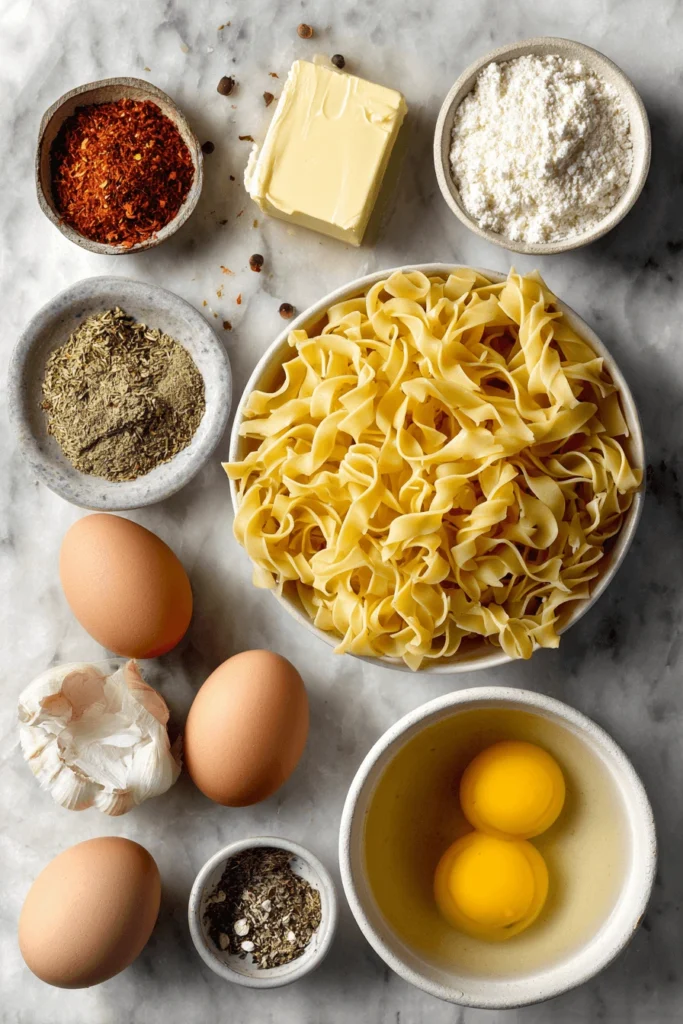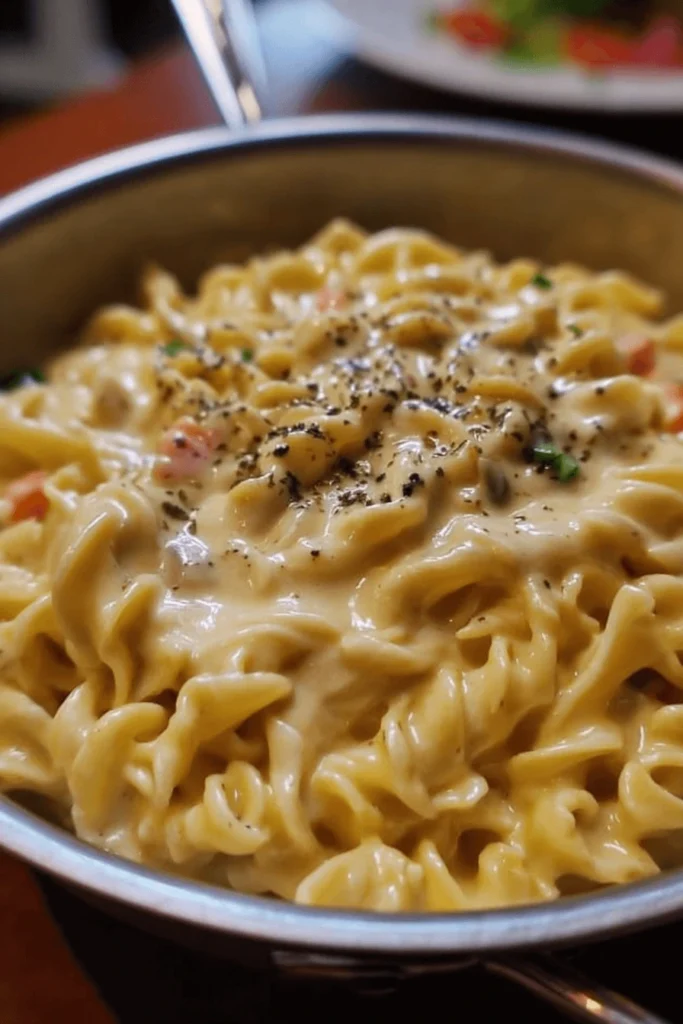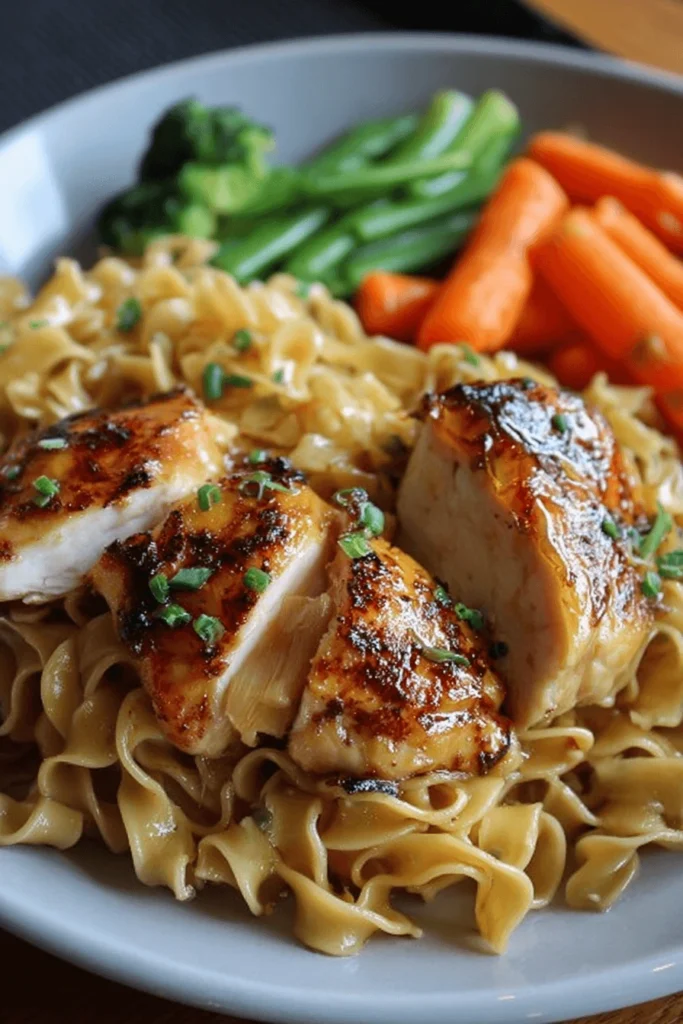If you’ve ever sat in a bustling school cafeteria or a cozy church hall, chances are you’ve tasted the humble yet unforgettable cafeteria noodles recipe. It’s the kind of dish that doesn’t need to show off—simple noodles, creamy broth, and a touch of comfort in every bite. Think of it as the recipe equivalent of a warm hug from your grandma. Sure, it may not look fancy, but boy, does it deliver on flavor.
In this article, we’ll walk through the story, ingredients, variations, and cooking secrets behind cafeteria noodles. You’ll also learn how to adapt it with chicken, ground beef, or even without cream of chicken soup. By the end, you’ll have all the tips to make the best cafeteria noodles recipe right in your kitchen.
Print
Cafeteria Noodles Recipe
- Total Time: 30 minutes
Ingredients
12 oz egg noodles
4 cups chicken broth
2 tablespoons butter or ghee
2 cups cooked shredded chicken (or substitute ground beef/turkey)
1 teaspoon salt
½ teaspoon black pepper
½ teaspoon garlic powder
½ teaspoon onion powder
Optional: 1 can cream of chicken soup (for creamy version)
Optional add-ins: peas, carrots, mushrooms, turkey bacon or beef bacon
Instructions
Cook the noodles: Bring chicken broth to a boil in a large pot. Add egg noodles and cook until just tender (al dente), about 6–8 minutes.
Add butter and seasoning: Stir in butter, salt, black pepper, garlic powder, and onion powder.
Add protein: Mix in shredded chicken, ground beef, or optional bacon. Cook for 2–3 minutes until heated through.
Optional creamy version: Stir in cream of chicken soup, reduce heat, and simmer for 5 minutes until creamy and well combined.
Add vegetables (optional): Stir in peas, carrots, or mushrooms, and cook until tender.
Serve: Transfer to bowls and enjoy warm. Pair with steamed vegetables or a crisp green salad if desired.
Notes
For extra creaminess, add a splash of heavy cream or a spoonful of sour cream.
Avoid overcooking noodles—they will continue to absorb liquid while simmering.
Leftovers can be stored in an airtight container in the fridge for 3–4 days or frozen up to 2 months.
- Prep Time: 10 minutes
- Cook Time: 20 minutes
Nutrition
- Serving Size: 4–6
Table of Contents
The Story Behind Cafeteria Noodles Recipe
The nostalgic roots of cafeteria noodles
Cafeteria noodles didn’t get their fame from a celebrity chef or a glossy cookbook. Instead, they became a star of everyday life in schools, hospitals, and church gatherings. The recipe was born out of practicality—large batches of egg noodles simmered in broth, thickened just enough to be hearty and satisfying. It was cheap, filling, and easy to make for a crowd. That’s why so many people still remember it fondly as a childhood favorite.
Why this simple recipe has stood the test of time
What makes the cafeteria noodles recipe with chicken or ground beef still relevant today? It’s versatility and comfort. You can keep it as plain and simple as you like, or you can dress it up with cream of chicken soup, beef broth, or even vegetables. Families love it because it stretches ingredients, fits into tight grocery budgets, and always tastes like home. In short, cafeteria noodles have survived the decades not because they’re flashy, but because they’re reliable, creamy, and downright comforting.
Ingredients for the Best Cafeteria Noodles Recipe
Essential base ingredients for cafeteria noodles with chicken
The beauty of a cafeteria noodles recipe lies in its simplicity. You don’t need a long grocery list to whip it up, just a few pantry staples and fresh basics. At its heart, the dish combines:
- Egg noodles – the traditional base that gives cafeteria noodles their chewy, comforting texture.
- Chicken broth – the soul of the dish, creating that savory flavor we all crave.
- Butter or ghee – adds richness and creaminess without overpowering.
- Cooked chicken – shredded rotisserie chicken, boiled chicken thighs, or leftovers all work perfectly.
- Seasonings – a touch of salt, black pepper, onion powder, and garlic powder are often enough to bring it together.

This is the foundation of the simple cafeteria noodles recipe you can build on.
Optional add-ins: cafeteria noodles with ground beef, turkey bacon, or veggies
One of the reasons this recipe is still so beloved is its adaptability. If you want to switch things up, try these additions:
- Ground beef – browning it first adds hearty flavor and makes a filling one-pot meal.
- Turkey bacon or beef bacon – smoky, savory notes without relying on pork.
- Vegetables – peas, carrots, or mushrooms blend seamlessly into the dish, making it heartier and healthier.
- Cream of chicken soup – for those who like an extra creamy version, this pantry staple is a shortcut to richness.
Think of this part of the recipe as your playground. Whether you prefer cafeteria noodles recipe with chicken or the cafeteria noodles with ground beef version, the ingredients bend to your taste.
Looking for a lighter pasta option? Try our refreshing lemon ricotta pasta that balances creamy and zesty flavors perfectly.
Step-by-Step Guide to Cooking Cafeteria Noodles Recipe
Preparing the noodles: egg noodles vs. other pasta options
The star of any cafeteria noodles recipe is, of course, the noodles themselves. Egg noodles are the classic choice—they cook quickly, soak up broth beautifully, and give that nostalgic chewy bite. But if you’re out of egg noodles, don’t panic. Wide fettuccine, spiral pasta, or even spaghetti can step in. The key is to cook them just shy of al dente so they don’t turn mushy when simmered in broth.
Here’s a quick noodle comparison table:
| Noodle Type | Texture in Broth | Cooking Time | Best For |
|---|---|---|---|
| Egg Noodles | Soft, chewy, absorbs flavor | 6–8 mins | Traditional cafeteria noodles |
| Fettuccine | Flat, hearty | 10–12 mins | Creamy versions |
| Spiral Pasta | Holds sauce in ridges | 9–11 mins | Ground beef variation |
| Spaghetti | Light, stringy | 8–10 mins | Simple, budget-friendly option |
Cooking in broth vs. water: how to add flavor while boiling
One of the best-kept secrets behind the best cafeteria noodles recipe is how you cook the noodles. Instead of boiling them in plain water, simmer them directly in chicken broth. This technique infuses every strand with flavor and saves you from having a bland base.
- For cafeteria noodles with chicken: simmer noodles in chicken broth, then stir in shredded chicken.
- For cafeteria noodles with ground beef: cook the beef first, drain excess fat, then use beef broth to simmer the noodles.
- For lighter versions: use vegetable broth for a milder taste.
The end result is a dish where the noodles aren’t just carriers for sauce but stars of the show. That’s what makes this recipe taste like comfort food every single time. If you love creamy noodle dishes like this one, you’ll definitely want to check out our Gouda mac and cheese for another comfort food favorite.
Cafeteria Noodles Recipe with Cream of Chicken Soup (and Without)
The creamy classic: cafeteria noodles with cream of chicken soup
When most people picture the traditional cafeteria noodles recipe, they’re thinking about the creamy version made with a can of cream of chicken soup. This pantry staple gives the noodles a velvety texture and rich, savory taste without needing hours of simmering. To make it, simply stir in one can of cream of chicken soup after your noodles have finished cooking in broth. Let it simmer for a few minutes, and suddenly you’ve got a thick, creamy comfort dish that feels like it came straight from a cafeteria line.

Pro tip: if you like your noodles extra creamy, add a splash of heavy cream or a spoonful of sour cream along with the soup. For a lighter touch, stick with just the broth and cream of chicken base.
Dairy-free or cream-free alternatives for lighter versions
Of course, not everyone wants the cream. Luckily, you can still enjoy a delicious cafeteria noodles recipe without cream of chicken soup. Here are a few easy swaps:
- Thickened broth: use cornstarch or flour mixed with a little water to create a silky texture.
- Mashed potatoes: a scoop of plain mashed potatoes stirred into the broth can add creaminess naturally.
- Dairy-free cream soups: opt for plant-based cream of mushroom or cream of celery to get the same body without dairy.
- Simple broth-only style: sometimes, less is more. Keeping the broth clear makes the noodles lighter and just as comforting.
No matter which path you take—creamy or broth-based—the cafeteria noodles recipe adapts easily to fit your taste buds and dietary needs.
Curious about trying other types of noodles? Our rice noodles guide breaks down everything you need to know about cooking with them.
Variations of Cafeteria Noodles Recipe
Simple cafeteria noodles recipe for weeknight meals
Sometimes you just need dinner on the table fast, and that’s where a simple cafeteria noodles recipe shines. All you need are egg noodles, chicken broth, butter, and a bit of seasoning. In less than 30 minutes, you’ll have a pot of creamy, savory noodles ready to feed the whole family. It’s budget-friendly, requires only one pot, and pairs beautifully with steamed veggies or a crisp green salad.
Here’s a quick formula for a weeknight win:
- Cook noodles directly in chicken broth.
- Stir in butter and a pinch of garlic powder.
- Add shredded chicken (optional) and let it all simmer for a few minutes.
That’s it—comfort in a bowl without the fuss.
Best cafeteria noodles recipe for family gatherings
If you’re aiming for the best cafeteria noodles recipe to impress a crowd, you can elevate the dish without complicating it. For potlucks, church suppers, or big Sunday dinners, consider these upgrades:
- Double the protein: mix chicken and ground beef for a hearty, stick-to-your-ribs version.
- Creamy twist: stir in cream of chicken soup and top with a sprinkle of cheddar cheese before serving.
- Veggie boost: add peas, carrots, or mushrooms for color and nutrition.
- Bacon alternative: crumble turkey bacon or beef bacon on top for smoky flavor.
This variation is not only filling but also customizable, which makes it perfect for sharing. Whether you stick with the cafeteria noodles with chicken version or try the cafeteria noodles with ground beef, it’s guaranteed to bring back memories and spark second helpings.
Cooking Tips for Perfect Cafeteria Noodles
How to thicken chicken broth for noodles naturally
One of the secrets to a creamy, restaurant-style cafeteria noodles recipe is getting the broth just right. You don’t always need cream of chicken soup—here are some natural ways to thicken it:
- Cornstarch slurry: Mix 1 tablespoon cornstarch with 2 tablespoons cold water and stir it into simmering broth.
- Flour roux: Melt butter, add flour, and whisk until lightly browned before adding the broth.
- Pureed vegetables: Cook carrots, potatoes, or cauliflower in the broth and then blend for a naturally creamy texture.
- Mashed potatoes: Stir in a small amount of leftover mashed potatoes to thicken the soup while keeping it smooth.
These tricks make your cafeteria noodles with chicken creamy and luscious without extra fat or processed ingredients.
Common mistakes to avoid when making cafeteria noodles
Even a simple dish can go wrong if you’re not careful. Avoid these common pitfalls:
- Overcooking noodles: Egg noodles cook quickly; overcooked noodles become mushy.
- Skipping seasoning: Even a basic broth benefits from a pinch of salt, pepper, or onion powder.
- Adding dairy too early: Cream or cheese can curdle if added directly to boiling broth. Wait until the heat is low.
- Neglecting texture balance: Make sure proteins, noodles, and optional veggies are cooked separately and then combined to maintain their individual textures.
Following these tips ensures your best cafeteria noodles recipe is always smooth, creamy, and comforting—just like you remember from school or family gatherings.
Serving Suggestions and Pairings
Serving cafeteria noodles with chicken or beef mains
The cafeteria noodles recipe with chicken shines on its own, but pairing it with other proteins can turn it into a complete meal. Consider:
- Grilled or roasted chicken thighs for a classic pairing that keeps flavors simple and comforting.
- Ground beef skillet served alongside the noodles, or folded into the dish for a hearty twist.
- Turkey or chicken sausage slices for a protein-packed option that adds a smoky flavor.

These pairings not only enhance the meal but also make it versatile enough for weeknight dinners or weekend gatherings.
Side dishes that complement cafeteria noodles perfectly
Cafeteria noodles are creamy and filling, so balancing them with lighter, flavorful sides works best. Some ideas include:
- Steamed or roasted vegetables like broccoli, green beans, or carrots for color and nutrients.
- Simple green salad tossed with olive oil and lemon to cut through the richness.
- Crispy garlic bread or dinner rolls for those who like to mop up every last bit of creamy sauce.
- Pickles or tangy slaw to add a hint of acidity, keeping the meal balanced and fresh.
With the right pairings, your cafeteria noodles recipe can become the centerpiece of a well-rounded, comforting, and satisfying meal.
Storage and Reheating Tips
Best ways to store leftovers without losing flavor
One of the great things about the cafeteria noodles recipe is that it keeps well, making it perfect for meal prep or leftovers. To store it properly:
- Refrigerate promptly: Transfer cooled noodles into an airtight container and keep them in the fridge for up to 3–4 days.
- Separate components if possible: If you added meat or vegetables, store them separately to prevent the noodles from absorbing too much moisture and becoming mushy.
- Freeze for long-term storage: You can freeze cooked noodles in a freezer-safe container for up to 2 months. Thaw overnight in the fridge before reheating.
How to reheat cafeteria noodles without them turning mushy
Reheating can be tricky, but these tips keep your noodles creamy and fresh:
- Stovetop method: Warm noodles gently over low heat with a splash of chicken broth or water. Stir frequently to prevent sticking.
- Microwave method: Cover noodles loosely, adding a little liquid, and heat in short intervals (1–2 minutes), stirring in between.
- Avoid overcooking: Noodles will continue to absorb liquid as they sit, so stop heating once they’re just warmed through.
By following these storage and reheating tips, your cafeteria noodles recipe with chicken will taste just as comforting the next day as it did the first.
FAQs on Cafeteria Noodles Recipe
Why are they called cafeteria noodles?
They earned their name because they were commonly served in school and institutional cafeterias. The recipe is simple, inexpensive, and easy to prepare in large batches, which made it a staple for feeding crowds efficiently.
What makes cafeteria noodles unique?
Cafeteria noodles stand out for their creamy texture, soft egg noodles, and versatility. Unlike other noodle dishes, they are comforting, easy to adapt, and can be made with chicken, beef, or even vegetarian variations.
Can I just boil noodles in chicken broth?
Yes! Boiling noodles in chicken broth instead of water infuses flavor directly into the pasta. This method is ideal for cafeteria noodles with chicken and helps reduce the need for extra seasoning.
How to thicken chicken broth for noodles?
You can naturally thicken broth by using a cornstarch slurry, a flour-based roux, or even pureed vegetables. These options create a creamy texture without relying on canned soup.
Do I cook egg noodles before adding to soup?
It depends on the recipe. For cafeteria noodles recipe, it’s best to cook noodles separately or partially cook them in the broth. This prevents them from overcooking and turning mushy while simmering with other ingredients.
Conclusion: Why This Cafeteria Noodles Recipe Will Always Be a Comfort Classic
The cafeteria noodles recipe remains a timeless favorite because it’s simple, creamy, and endlessly adaptable. From weeknight dinners to large family gatherings, this recipe brings comfort, flavor, and nostalgia to every table. Whether you stick to the classic chicken version, try ground beef, or experiment without cream of chicken soup, these noodles never disappoint.
Find more delicious recipes on DifferentyRecipes Pinterest, and stay inspired with the newest tips and ideas by following DifferentyRecipes on Facebook.


